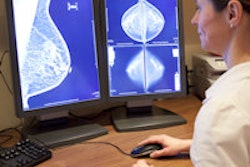
Clinical studies have shown that women with dense breast tissue have a twofold increased risk of developing primary breast cancer. But women with dense tissue also have an increased risk of developing cancer in the other breast, according to a study published online January 30 in Cancer.
The finding could affect the management of women with dense tissue who have been diagnosed with primary breast cancer, wrote researchers from MD Anderson Cancer Center in Houston.
"Mammographic breast density may be considered a risk factor for contralateral breast cancer in prognostic models to change ... clinical practice [and] adopt specific recommendations using more enhanced surveillance with imaging techniques such as MRI," wrote the group led by Dr. Akshara Raghavendra.
Increased risk?
The question of whether breast density is a risk factor for contralateral cancer has remained unanswered in the clinical literature, which is why Raghavendra's team conducted the study.
"Although [breast density as an independent risk factor for breast cancer] is well-established, to our knowledge the relationship between breast density and contralateral breast cancer is less clear," the authors wrote. "The purpose of the current study was to determine whether increased breast density at the time of diagnosis of primary breast cancer was associated with the development of ... contralateral breast cancer."
Raghavendra and colleagues used data from January 1997 to December 2012 to identify 229 breast cancer patients who developed contralateral cancer and 451 breast cancer patients who did not. The women who developed contralateral breast cancer were matched with the controls by age, year of diagnosis, and hormone receptor status of the primary breast cancer. For all of the women, breast tissue density was assessed at the time of diagnosis of the primary cancer as either nondense (fatty or scattered density) or dense (heterogeneously dense or extremely dense).
Among the women who developed contralateral breast cancer, 60.7% had dense tissue, the researchers found. Meanwhile, among the women who did not develop contralateral breast cancer, 51.7% had dense tissue. Women with dense breasts had a significantly greater risk of developing contralateral breast cancer, with an odds ratio of 1.80 (p < 0.01), than women without dense breasts.
In a secondary finding, the team discovered that patients who underwent chemotherapy or endocrine therapy were less likely to develop contralateral breast cancer.
Density matters
The study suggests yet another reason for vigilance when assessing breast density, according to the authors.
"Because the effect of breast density on cancer risk persists for at least five to 10 years after assessment, breast density at the time of primary breast cancer appears to be important," the group concluded.



















